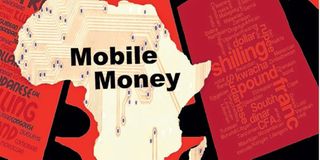Mobile money transfer more costly for the poor

The cost of mobile money transactions has pushed up the cost of doing business in Africa. GRAPHIC | NATION MEDIA GROUP
Kenya is among the top five African countries in mobile penetration, even though the cost of mobile transactions remain high for poor households and businesses.
The cost of mobile money transactions has pushed up the cost of doing business on the continent.
A new report by Egyptian Investment Bank EFG Hermes shows that although financial inclusion has taken root on the continent, it has come at a huge cost to the consumers of mobile money services.
The report, Deepening Financial Inclusion, But at a High Cost, shows that Ghana has the highest rate of adult mobile penetration on the continent followed by Botswana, Kenya, Zambia and Nigeria.
Within East Africa, Kenya leads in terms of adult mobile penetration, followed by Tanzania, Rwanda and Uganda.
The report, which was released last month, shows that whereas there is improvement in the penetration of mobile banking across sub-Saharan Africa, transaction costs still remain high.
For instance, the average cost of sending $1 through the mobile money platform to a user on the same network is 9.5 per cent of the value of the transaction, while the cost of sending $20 is 2.6 per cent.
In Kenya, the cost of sending and withdrawing $5 through Safaricom’s M-Pesa platform is currently fixed at nine per cent of the value of the transaction.
“Except for EcoCash in Zimbabwe, the more you send and withdraw the less it costs. Why is this acceptable?” the report asks.
Borrowing through Safaricom’s overdraft facility Fuliza is more expensive for smaller amounts. The report notes that the effective cost of borrowing $1 on your mobile using M-Shwari and Fuliza accounts in Kenya is 7.5 per cent per month and two per cent per day. However, the annual percentage rate (APR) of borrowing $25 on Fuliza is only 17 per cent, implying that Fuliza is disproportionately expensive for the poor.
THE CASE OF FULIZA
“If the costs of mobile transfers are high, the cost of borrowing on the mobile is usury. This is particularly true of Safaricom’s latest overdraft facility — Fuliza. The effective cost of borrowing $1 from Fuliza is two per cent per day with an APR of 137,641 per cent. However, the cost of borrowing $25 is 0.04 per cent per day with an APR of 17 per cent.
“While we are encouraged by the depth of mobile banking across sub-Saharan African countries, we believe that now is the time to focus on the costs and would encourage both the central banks and ICT regulators to review the cost of this financial inclusion because the current tariff rates are disproportionately expensive for the poor.” According to the report, the cost of sending and withdrawing $5 is more than double the cost of sending $20 on M-Pesa (in Kenya) and MTN MoMo (in Uganda).
The report notes that only in Zimbabwe is it cheaper to send and withdraw $5 vis-a-vis $20, but it will still cost a user seven per cent of the value of the transaction.
Central banks and ICT regulators should level the playing field for financial inclusion and policy makers should remove all prescriptive rates and open up markets to competition in order bring down mobile money transaction costs.
“With regard to Kenya in particular, we strongly believe that it is absolutely inconsistent to regulate bank lending rates and not all borrowing rates. Competition on a level playing field is all that is needed to bring down tariffs and rates across sub-Saharan Africa,” the report says.




